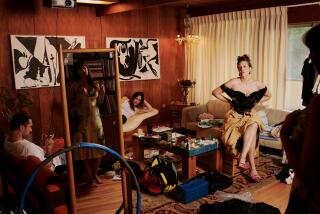You might not know it by looking, but every newspaperman has his own way of dressing for success
- Share via
In writing the other day about the impossibility of dressing properly in Southern California--especially for men--I didn’t mention the peculiar difficulties for newspapermen.
Newspapermen always have been notoriously poor dressers. That tradition has been changed somewhat by television. Anchormen, at least, are expected to wear suits and neckties, though sometimes their bizarre taste reflects the profession’s old idiosyncrasies.
(I use the word newspapermen deliberately, rather than the genderless reporters , because newspaper women are not included in this critique. The newspaperwomen I have known always have managed to look chic, compared to their male colleagues, at least, despite the business they’re in.)
Because of the unpredictability of its demands, the business was no place for snappy dressers. A reporter might be sent out to the Beverly Hilton in the morning to interview the president of the World Bank, as I once was, and that afternoon be sent up into Angeles National Forest to cover a forest fire, as I was more than once.
Besides, reporters used to affect an anti-Establishment look, and their clothing reflected not only their disregard for fashion but also their pauper’s pay.
Years ago the New Yorker ran a classic cartoon that showed half a dozen young men in sloppy unpressed suits with neckties hanging loose and shapeless felt hats with press cards in the bands; cigarettes hung from their lower lips. They were loafing on the steps of a classic Greek building whose frieze bore the inscription “SCHOOL OF JOURNALISM.”
Today some reporters, especially in television, make enough money not only to regard themselves as a part of the Establishment, but also to dress in style: for example, the impeccable Walter Cronkite, Tom Brokaw and our own Jess Marlow.
Jere Witter, a veteran colleague, writes that he remembers when news photographers wore hats, ties and overcoats.
“One of ours,” he recalls, “on the San Francisco Chronicle, got stabbed with a screwdriver which went through three layers of clothing. The clothing saved him. . . .”
San Francisco was different. In Los Angeles I never saw a photographer in hat, tie and overcoat. I doubt that any photographer I knew even owned an overcoat.
Newspaper photographers were an intrepid lot in those early days, and so were their subjects. They didn’t shoot dozens of pictures on roll film with automatic flash as they do today, hoping for one good shot; they had to carry flash powder, which they exploded in a flash pan just as their quarry appeared, and the picture was recorded on a photographic plate which then had to be turned or replaced. These explosions of flash powder account for the look of astonishment on the faces of celebrities in photographs of those days.
Witter also recalls that a boss of his at the Chronicle, Stanleigh Arnold, wore the same tie for two years just to see if his wife would notice. “She finally did, and said, “It seems like you’ve been wearing that tie for a month!”
That reminds me of Bruce Russell, the political cartoonist here at The Times before Paul Conrad. Bruce invariably, day in and day out, wore a white shirt with a yellow necktie. I was told that Bruce favored this style because he was colorblind, and figured he’d be safe if he stayed with the same combination every day.
I think I have already told here how Agness Underwood, the sometimes rowdy city editor of the Herald-Express, once assigned me to interview Kirsten Flagstadt, the famous Wagnerian soprano, when I was wearing my forest green Marine Corps pants from World War II and a red-and-black check lumberjack. Agness enforced no dress code on her staff of sometimes brilliant misfits, drunks, poets, eccentrics and fallen Ph.D.s, but ever since then I have tried to dress as if I were going to interview an opera star.
Witter also remembers that one Saturday he showed up at a nudist convention in Venice wearing a coat and tie (with pants, of course).
“One sunbather asked why I came on so formal; I told her I was going to a funeral next, which was true.”
I also took my clothes off one day at a nudist camp in pursuit of a story. My defense for that is the one used by the young British subaltern in World War II who was court-martialed for running naked down a Raffles hotel hallway in pursuit of a Wren. He pleaded that he was properly dressed for the activity in which he was engaged, and was acquitted.
Witter points out that today it matters how you look for the television cameras, but only from the waist up. “A tie and plain jacket makes you feel safe because you never know where you’re going to be sent. I always wore a tie and blazer over wash-pants and cowboy boots. That way you can wade through muck all morning and cover an afternoon trial, scrunched up, pretending your lower half doesn’t exist. . . .”
Now I’m always going to wonder what Jess Marlow is wearing below that natty shirt, tie and jacket. Jogging pants?
Witter has survived by going down the middle. “I’ve dressed the same for 40 years, never in style and never out of it. I avoided polyester and the gold medals on the suntanned chest, longish hair and whiskers, the green suits of the ‘60s that made everybody look like grasshoppers, and the Nehru jacket (a pal of mine, Ken Rosen, got stuck with 10 of them).”
Nowadays most of us just try to look like Ronald Reagan.






